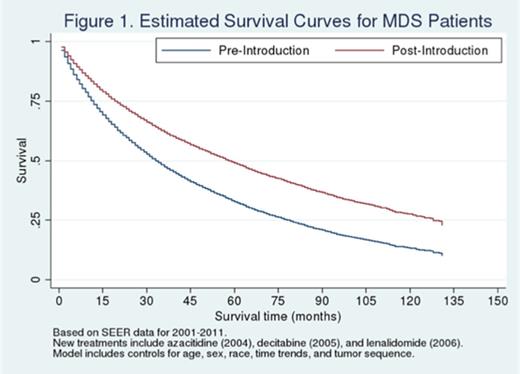Abstract
Cancer survival has improved much since the 1970s, particularly for non-Hodgkin's lymphoma, breast, and colon cancer (Pulte, Arch Int Med 2008; Espey, Cancer 2007; Breen JNCI 2001). Yet some argue that newer treatments offer minimal survival gains at high costs (Kantarjian, Blood 2014). This motivates rigorous evaluation of the clinical and overall economic impacts of new cancer therapies. A recent study (Yin, Am J Manag Care 2012) showed that the introduction of tyrosine kinase inhibitors for chronic myeloid leukemia led to significant survival gains in the community, a value that far exceeded the cost of therapy. Using the methods employed by Yin et al., this study estimated the value of survival gains in myelodysplastic syndromes (MDS) attributable to the introduction of 3 therapies: azacitidine (2004), lenalidomide (2005), and decitabine (2006). While survival gains in clinical settings are well established (Fenaux, Lancet Onc 2009; Lubbert, J Clin Onc 2011; Fenaux, Blood 2011), survival gains in the community are unknown.
We conducted 3 distinct analyses. First, we used multivariate Cox proportional hazards models to estimate the increase in survival associated with the introduction of new MDS therapies for 38,085 patients diagnosed from 2001–2011 in the Surveillance, Epidemiology, and End Results Program registries. The key variable in the hazard model was the post-2006 indicator variable, which equaled 1 in all years following 2006, the first year when all 3 therapies were available. The coefficient on the post-2006 indicator reflected the decline in the hazard rate associated with the introduction of the 3 therapies, relative to the years prior to their introduction (2001–2003). We estimated that the introduction of these 3 therapies is associated with a hazard ratio of 0.901 (p<0.10).
Second, utilization of the 3 new therapies from 2006 to 2012 was estimated with the Optum Touchstone commercial claims database (Optum). Approximately 25% of MDS patients had claims for at least 1 of the 3 novel treatments consistently over this period, resulting in a hazard ratio of 0.901 and an overall increase in median survival from 33 to 57.5 months, conditional on treatment observed in the community (Fig. 1).
Finally, we calibrated an existing economic model (Becker et al., Am Econ Rev 2005) to value survival gains. The annual value of survival gains associated with innovative treatmentsroughly $208,000 per yearequaled the estimated amount a patient would be willing to pay for the higher survival profile associated with the new therapies.
Table 1 compares the value of survival gains to costs, where annual treatment costs of the new therapies from 2006–2012 are estimated using Optum. The value of survival gains is estimated to exceed the cost of therapy, with the annual and lifetime net benefit to patients of $68,200 and $238,700, respectively. The total present discounted value of the survival gains and costs considers future MDS incident cohorts together with the current cohort, and accounts for patent expiry (generic versions of azacitidine and decitabine became available in 2013). Assuming that the patent on lenalidomide expires in 2020, and that costs fall to 10% of current prices post expiry, we estimate that 85% (= $86.5B / $101.5B) of the total value accrues to MDS patients, and 15% accrues to manufacturers.
Value of Survival gain for MDS patients
| . | Annual Value per Patient . | Lifetime PDV per Patient . | PDV for all Current and Future Cohorts . |
|---|---|---|---|
| (1) | (2) | (3) | |
| Value of survival gain | $208,000 | $728,000 | $101.5 billion |
| Cost | $139,100 | $489,300 | $15.0 billion |
| Patient net benefit | $68,200 | $238,700 | $86.5 billion |
| . | Annual Value per Patient . | Lifetime PDV per Patient . | PDV for all Current and Future Cohorts . |
|---|---|---|---|
| (1) | (2) | (3) | |
| Value of survival gain | $208,000 | $728,000 | $101.5 billion |
| Cost | $139,100 | $489,300 | $15.0 billion |
| Patient net benefit | $68,200 | $238,700 | $86.5 billion |
Notes: MDS indicates myelodysplastic syndromes. All values reported in 2013$. Column (1) reports the per-patient annual value, cost, and net benefit of treatment to patients. Column (2) reports the present discounted value (PDV) over a patient's lifetime (estimated at 3.5 years on average). Column (4) reports PDV for all current and future incident cohorts. We estimate the incidence cohort size is 14,650, and assume a 3% annual discount rate.
This study measured the value of survival gains attributable to the introduction of 3 novel therapies for MDS and found significant benefits from improved survival. For current and future MDS patients, these 3 therapies will generate over $100B in value due to survival gains, of which the vast majority85%will accrue to patients.
MacEwan:Celgene: Consultancy, Research Funding. Yin:Celgene: Consultancy, Research Funding. Khan:Celgene: Employment, Equity Ownership, Leadership - Vice President Other. Kaura:Celgene: Employment, Equity Ownership.
Author notes
Asterisk with author names denotes non-ASH members.


This feature is available to Subscribers Only
Sign In or Create an Account Close Modal